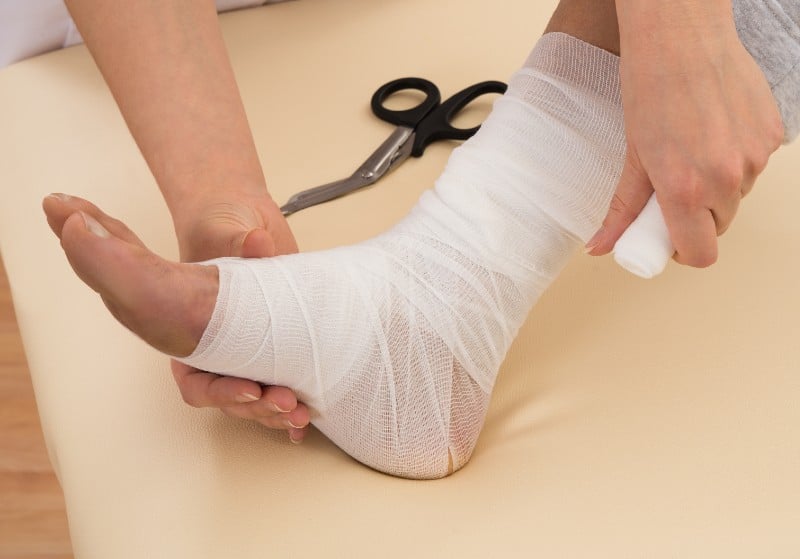Diabetic Wound Care
Diabetes is an endocrine disease that affects an alarming number of Americans. There are over 29 million citizens afflicted with this condition, and almost 80 million more who have higher-than-normal blood sugar levels (“pre-diabetes”) and are at risk of outright developing diabetes.
The core problem with diabetes is the damage elevated blood sugar (glucose) levels does to body systems, including the nervous, circulatory, and immune systems. This plays a major role as we look at diabetic wound care, one of the valuable services you can receive at Heartland Foot and Ankle Associates.
The Threat Of A Diabetic Wound
When used in the context of diabetes, the word “wound” can pertain to all manners of issues, including cuts, bruises, blisters, calluses, burns, lumps, and even ingrown toenails. To make it a bit easier, you can think of a diabetic wound as being any injury, condition, or abnormality you would not expect to find on a healthy, otherwise normal foot.
No matter which of these seemingly minor problems you find, it’s a cause for concern and needs to be evaluated and treated by an experienced professional like Dr. Melissa Lockwood. Whereas issues like these are not usually a big concern for individuals who are not diabetic, wounds can break down and become dangerous foot ulcers when diabetes is in the picture.
The reason this happens goes back to the damage to those aforementioned body systems. Problems start when peripheral nerves—the ones that enable you to feel physical sensations—are damaged from excess sugar. This can cause painful sensations, but it’s even more concerning when the nerves are damaged to the point they do not provide any sensation at all. With this numbness, it is entirely possible to sustain a small cut, have a toenail become ingrown, or experience any other injury or condition without even knowing about it.
Given that you don’t know about it, you won’t likely take measures to address the problem. This is worrisome because an impaired circulatory system means that the damaged area will not receive an adequate blood supply to heal in a normal fashion. Further, the compromised immune system is unable to fight off potential contaminants. Combined, these factors lead to an increased risk of gangrene (tissue death).
There is no cure for gangrene, and the only solution to prevent it from spreading is amputation. As such, it’s extremely important that you A) know how to prevent diabetic wounds and B) have issues resolved at the earliest possible opportunity.
Ulcerations
Foot ulcers and infections for diabetic patients can become serious if left untreated. Since diabetic patients often have neuropathy and P.A.D., a minor cut or injury can become a serious infection. The inability to feel the sore and the inability to heal properly can result in hospitalization or possibly amputation.
Common foot problems that can lead to ulcerations or infection are:
- Corns
- Calluses
- Blisters
- Ingrown Toenails
- Bunions
- Warts
- Athlete’s Foot
- Hammertoes
- Dry or cracked skin
At-Home Inspection Is Essential
Inspecting your feet on a daily basis is critical. Given the importance of catching problems early—and then seeking care as soon as possible—a daily foot inspection needs to be part of your greater diabetic foot care plan.
The best practice for this is to inspect your feet carefully and thoroughly every single day. To help create a routine, you should do this at the same time. For many individuals living with diabetes, a daily inspection while getting ready for bed works quite well. If you are unable to see the bottoms of your feet, either use a long-handled mirror or ask a loved one to help. In the event any cuts, scrapes, blisters, swelling, or other skin and nail issues are present, contact Heartland Foot and Ankle Associates and schedule an appointment with Dr. Lockwood.
If you become aware of any signs of infection—redness, fever, etc.—you need immediate medical attention.
Reducing Your Risk Of Diabetic Wounds
Perhaps the most vital component of diabetic care is to manage the disease. Monitor your blood glucose levels and keep them in a normal range. Remember, excess sugar is like poison to your body systems when you are diabetic.
In addition to glucose monitoring and control, you simply must protect your feet. You can learn more about this by visiting our webpage on diabetic
How Heartland Foot & Ankle Associates Can Help
Our office provides a wide range of foot care services, including ones for diabetic feet. We can help you create a plan to keep your feet protected and safe. We also provide diabetic foot checkups, prescribe diabetic shoes, and can help educate you on the best practices to lower your risk of serious medical complications.
For more information, call us at (309) 661-9975 or take advantage of our online contact form to get in touch with our Bloomington, IL podiatrist practice.

